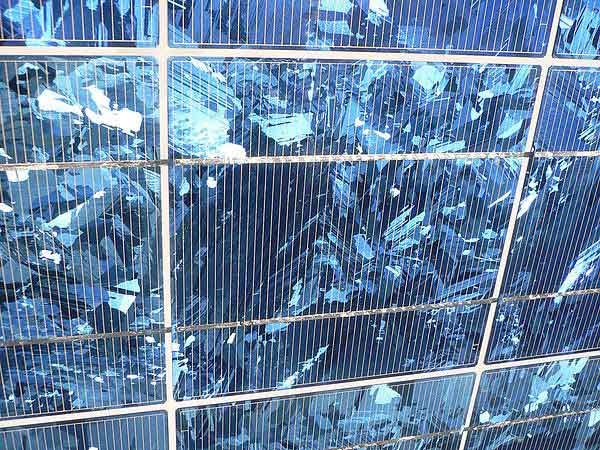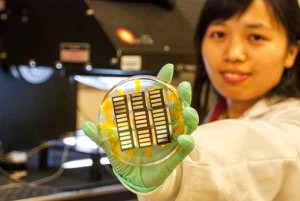
UCLA researchers have developed a new process that uses perovskite materials to produce “highly efficient” solar cells. Credit: UCLA Henry Samueli School of Engineering and Applied Science
Engineers at UCLA have discovered an innovative process that uses photovoltaic materials in the production of “highly efficient” solar cells.
These “perovskite” materials are not made of the mineral of the same name, but mirror its crystalline structure—a particularly effective channel for turning light to electricity. (Perovskite-based solar cells seem to be a hot topic, so much in fact that Science deemed it a 2013 breakthrough. Read more about these light-absorbing semiconductors here.)
The research team, led by Yang Yang, professor of engineering at UCLA’s School of Engineering, was able to create perovskite crystals of various compositions—inorganic (methyl ammonium halide) and organic (lead halide)—to be turned into “a thin film sandwiched between two electrodes.” The result was a “vapor-assisted” solar-cell production process far more efficient and cost-effective than those currently available.
According to a UCLA press release, this process involves “coating a substrate with the inorganic component and then treating it in a steam bath of organic molecules at about 150 degrees Celsius. The organic material infiltrates the inorganic matter and forms a compact perovskite film that is significantly more uniform than the films produced by the wet technique.”
In testing, Yang and team were able to fabricate solar cells with a more-than-12 percent power conversion rate—a number comparable, if not better, than those of their amorphous silicon counterparts—and are diligently working to best their previous performance. They also note that the cells produced in the lab, about the size of a postage stamp, show promise in terms of large-scale commercial applications—welcome news for industry and environmentalists alike.
“Perovskite cells are one of today’s most promising solar technologies,” said Yang. “Over the last year, the gains of perovskite solar cells in efficiency of converting sunlight to electricity far outpace the incremental gains of other solar materials.”
To read an in-depth piece on the team’s research and method, head on over to the UCLA newsroom.
Featured image above: Polycrystalline silicon solar panel. Credit: Wikipedia.

